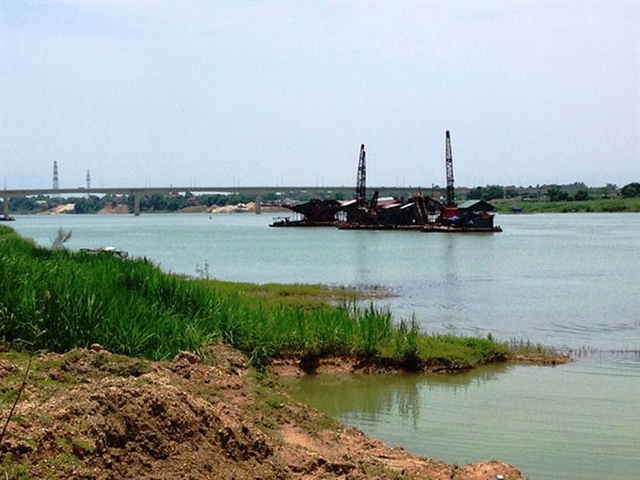 Society
Society


|
| The number of sand and pebble depots along Hà Nội’s rivers is double or even triple the number approved by city authorities. — Photo hanoimoi.vn |
How many sand and pebble mining operations are currently along the river banks in Hà Nội?
According to the latest report, the number of sand and pebble depots along Hà Nội’s rivers is double or even triple the number approved by city authorities.
Before 2017, Hà Nội was allowed to have only 91 sand depots. But the actual number of depots and transfer points jumped to almost 300. Thanks to big efforts from the city's agencies, the number of illegal sand mining sites has been cut down to some 200 along the banks of the Red, Đuống, Đà and Cầu rivers. Though the number has been cut by a third, these illegal sites are still a problem for municipal authorities.
What are the negative impacts of illegal sand and pebble extraction?
Illegal sand extraction and transportation from river beds have caused serious damage to all of Hà Nội’s river dykes as well as the rivers. They pose a threat to the safety of people living along the river dykes and their property, particularly during the flood season. Last but not least, heavy trucks carrying sand have seriously damaged the dykes and caused pollution when sand flies off the trucks and into the homes of people living nearby.
Why have the authorities not given out punishments for such serious acts?
There are many reasons, but here I just want to mention the three main ones.
First is the high demand for construction materials from the general public.
Second, the lax management of local authorities has led to severe environmental problems and enabled the misuse of agricultural land for other purposes, particularly as a transfer place for sand and pebbles used in construction.
And finally, it is down to poor law enforcement by concerned authorities, particularly local authorities and inspectors, in handling violations.
What can be done to stop violations?
To put a halt to these violations requires strong co-ordination from many parties. From the perspective of the Hà Nội Department of Natural Resources and Environment, I think we have to focus more on inspections to detect and then stop the violations. We’ll also have to levy heavy fines on those who violate the law. In the meantime, we’ll petition the Hà Nội People’s Committee to take stronger steps in the management and exploitation of mineral resources and the transportation of construction materials in the city.
Has the Hà Nội Department of Natural Resources and Environment developed a plan to work with concerned agencies to put a halt to illegal mining?
The department will develop a plan that involves agencies and localities in the effort to stop illegal sand extraction from Hà Nội's rivers and prevent the driving of overloaded trucks on dykes of the Red River and Đáy River.
We have targeted that by July 31, all illegal sand and, pebble depots inside the city will be removed. We’ll also work closely with authorities from outlying districts to find sites they can allocate to serve as storage and transport sites for sand and pebbles used in construction in the city centre.
We will also co-ordinate with agencies from neighbouring provinces to prevent illegal sand extraction from river beds in their provinces.
Of course, we will ask the Hà Nội Department of Transportation and other agencies to co-ordinate to prevent the establishment of illegal construction material depots. VNS




